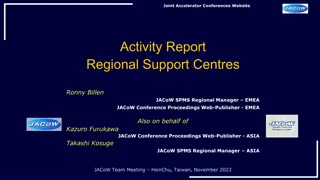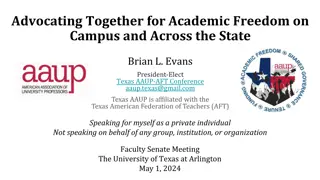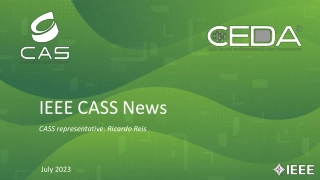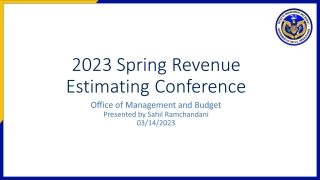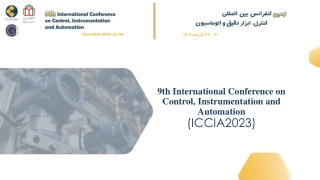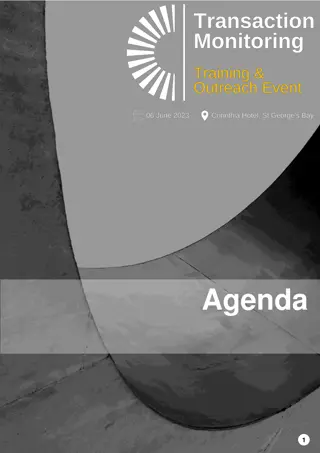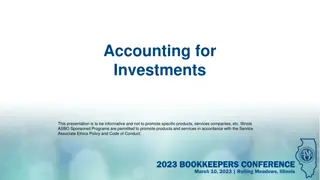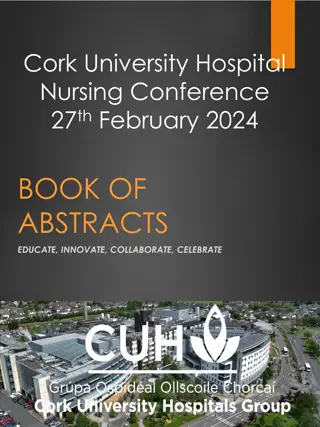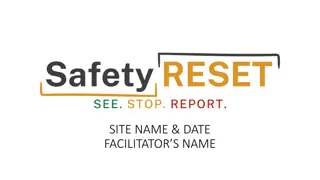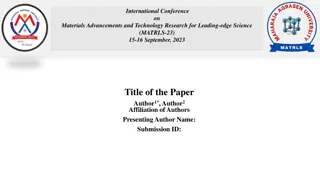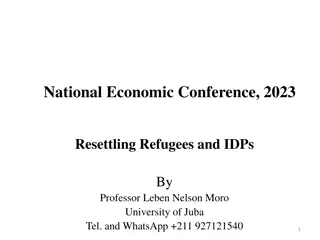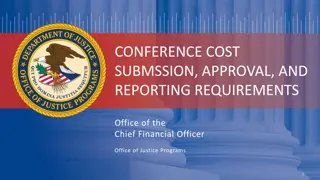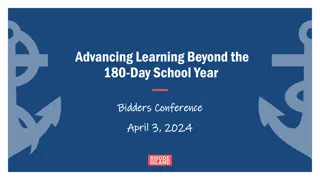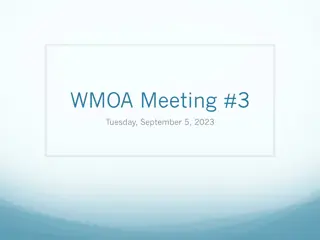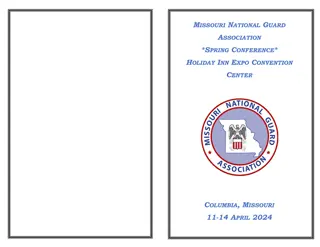EIRC Regional Conference
Amid changing risks and current challenges in the auditing profession, building capacity and ensuring audit quality are critical. Addressing increased regulatory oversight, empowering engagement teams, developing specialized functions, and embracing technology are key strategies for growth and success.
Download Presentation
Please find below an Image/Link to download the presentation.
The content on the website is provided AS IS for your information and personal use only. It may not be sold, licensed, or shared on other websites without obtaining consent from the author. Download presentation by click this link. If you encounter any issues during the download, it is possible that the publisher has removed the file from their server.
Presentation Transcript
EIRC Regional Conference Build Capacity, Elevate Standard & Ensure Growth Building Capacity to Navigate the Current Challenges, & Ensuring Audit Quality CA. Manoj Fadnis Past President ICAI 1
Building Capacity to Navigate the Current Challenges & Ensuring Audit Quality CHANGING RISKS AND CURRENT CHALLENGES Changing Risks in Profession Increased risks, responsibilities and expectations from auditors due to dynamic financial and economic backdrop Several scams surfacing where Cas are involved/presumed to be involved Under the microscopic lenses of the regulators/stakeholders/society E-governance in government administration Constant amendments in GST, Companies Act, Ins AS, Bankruptcy code etc. Introduction of rotation of auditors, UDIN, valuation rules etc. Current Challenges Rapidly increasing overall cost vis- -vis fees/revenue Client retention and loyalties, regulatory involvement in client appointments Attracting and retaining the right talent/human resource Burden of the client s tax defaults and non-compliances also on the practitioners Increased competition joint audits, specialisation, technological advancements Complex Client IT structures, Threat to data security/privacy Shift in practice from traditional to non-conventional alternatives o o o o o o o 2
Building Capacity to Navigate the Current Challenges & Ensuring Audit Quality CURRENT REGULATORY CHALLENGES Regulatory Challenges & Key Observations Increased Regulatory oversight. Focused reviews and penal actions taken by Regulators Summary of some of the key observations by various regulators: o Entities being in same network firms provided non-audit services restricted u/s144 and audit services. o Issue of audit report, reviews by the EP, EQCR, reporting to TCWG all on the same day o The EQCR partner did not perform any independent and objective evaluation of significant judgements. No review comments/observation from the EQCR Partner documented on any of the matters discussed in the audit file. o Qualification of EQCR questionable in terms of competence and experience o Engagement letter containing a provision for success fee - illegal as per Chartered Accountancy Act, 1949. o Failure to address all the requirements of independence as envisaged under Code of Ethics and the provisions of the Companies Act, 2013. o Lack of professional skepticism - specifically in areas like evaluation of ROMM, Fraud triangle, accounting policies, investment policies, impairment testing of investments/assets, use of materiality, verification of management estimates etc. o Non-compliance with the Standards on Auditing and Standards on Quality Control o Issue of an unqualified/qualified audit opinion in situation where an adverse opinion should have been issued 3
Building Capacity to Navigate the Current Challenges & Ensuring Audit Quality BUILDING CAPACITY Building Capacity Developing next line of leaders and empowering engagement teams Developing specialised functions and verticals within the firm Adequate resource planning Encouraging and retaining talent Learning and development through trainings and knowledge management Embracing non-conventional and out-of-the-box ideas Harnessing technology to bring in efficiency Recovery rate and Financial management Deeper client connects and communication Leveraging expertise amongst the professional firms through collaborations Learning through shared experiences Exposure to global practices and approaches 4
Building Capacityto Navigate the Current Challenges & Ensuring Audit Quality BUILDING CAPACITY AND ENSURING AUDIT QUALITY Quality Approach in Building Capacity The changing business scenarios have emphasised the need for heightened focus on quality and capacity building to mitigate the risks and challenges and in-turn achieve the firm s overall quality goals. Quality imperative - right from proposing a client to delivery of service and even thereafter Aligning Quality to all aspects of firm s Values, Vision and Mission Leadership Tone at the top - most important A designated Quality Leader and an empowered Quality Team Flow of quality expectations as a top-down approach Structured involvement of Leadership Quality to be one of the prime importance in Partner evaluation 5
Building Capacity to Navigate the Current Challenges & Ensuring Audit Quality BUILDING CAPACITY AND ENSURING AUDIT QUALITY Independence of Auditors Independence of auditors - backbone of forming an objective opinion Personal and Firm level independence Conflict of interests and non- audit services Structured regulatory requirements and compliances on independence of auditors Ensure compliance through: o Comprehensive Independence policies, procedures, tools etc. o Strengthening overall client KYC and independence checks prior to proposing a new client o Maintenance of contemporaneous client and service masters/list for on-going compliances o Setting in place procedures for approval of non-audit services to audit/assurance clients o Training of partners and staff on personal independence matters o Disciplinary actions which may extend to replacement from engagement team, termination from the firm etc. o Timely reporting to TCWG of the client, any significant non-compliances impacting the auditor s independence. 6
Building Capacity to Navigate the Current Challenges & Ensuring Audit Quality BUILDING CAPACITY AND ENSURING AUDIT QUALITY Human Resource Management People are the key in a service organisation Right from onboarding to exit - Quality in HR process - o Resource planning to ensure competence, expertise, resource bandwidth/strength and manage overall staffing budgets o Recruitment interviews in line with requirements o Screening/Background checks to ensure quality staffing. o Onboarding sessions and general firm expectations o Continuous trainings o Constructive appraisals/feedbacks o 360-degree feedback for upward/coaching improvements o Promotions/motivation o Retaining trained and quality staff o Offering varied experiences and exposures, growth plan and career planning, mentoring, employee benefit programmes, employee engagement activities and bonding o Opportunities to lead o In depth exit interviews and inward feedback o Seemless HR processes 7
Building Capacity to Navigate the Current Challenges & Ensuring Audit Quality BUILDING CAPACITY AND ENSURING AUDIT QUALITY Client Services Planned strategy for approaching prospective clients Relationship Partners Developing in house expertise to offer one stop solutions wherever possible Developing other lines of services and verticals viz. Tax, IT etc. to provide audit support Reporting audit matters to TCWG on periodic basis Regular Client Connect and value-adds Client Feedback and actions taken Detailed initial acceptance procedures along with and further to proposal o Know Your Client (KYC) Risk Category/Industry/ PIE/KMP/UBO etc. o Anti Money Laundering assessments o Significant High-Profile relationships/involvement of PEPs etc. o Independence of the Firm (as detailed above) o Competence to serve the client Regular continuance client and engagement reassessments to manage any changed situations 8
Building Capacity to Navigate the Current Challenges & Ensuring Audit Quality BUILDING CAPACITY AND ENSURING AUDIT QUALITY Engagement Performance Assignment and Supervision Assignment of Team - allocation/ mobilisation commensurate with the client size and nature and; availability and competence of the resources Adequate team structure comprising the EP, EQCR, Team Manager, seniors and other team members Defined roles and responsibilities of each team member Knowledge of the professional standards, laws, regulations and regular technical trainings Robust Engagement Supervision, coaching, reviews and trainings Involvement of EQCRs (where applicable) at all the significant stages of engagement Appropriate documentation of the work performed and the timing and extent of the review Adequate review trails and time stamping Timely consultations with the experts in the Firm and obtaining necessary approvals wherever required 9
Building Capacity to Navigate the Current Challenges & Ensuring Audit Quality BUILDING CAPACITY AND ENSURING AUDIT QUALITY Digital and IT Tools Technological upscaling need of the hour Aligning to global trends and competitive firms in automation and use of technology Harnessing efficiency through Digitisation, AI, BOTs, IT Tools etc. in performing engagements and monitor activities. Improved effectiveness of work done, compliances with standards, documentation etc. Reduced inadvertent overlooks/miss-outs Processing large data seamlessly Reduced pressure on human resource and overall enhanced employee engagement Cost Revenue benefits, fee negotiations, margin improvements Enhanced client delivery experience Some of the IT Tools are as follows: o Data Analytics Software (Tableau, Power BI, or ACL Analytics) o Cloud-Based Collaboration Tools (Microsoft Teams, Slack, or Google Workspace). o Cybersecurity Tools o Electronic Working Papers o Continuous Monitoring Tools o Audit Management/Assistance Software 10
Building Capacity to Navigate the Current Challenges & Ensuring Audit Quality BUILDING CAPACITY AND ENSURING AUDIT QUALITY Internal Excellence Knowledge Management Systems and Tools Maintaining and updating details such as qualifications, experience, knowledge, skills, etc. of all personnel Promoting an internal culture based on quality Effective information and communication regarding quality matters Internal Control, Compliance and Quality Management System Regular benchmarking with the AQMM standards Internal Quality Reviews Recognising and rewarding high quality work QUALITY A CONTINUOUS PROCESS AND NOT A ONE TIME ACTIVITY 11
THE INSTITUTE OF CHARTERED ACCOUNTANTS OF INDIA (Set up by an Act of Parliament) CENTRE FOR AUDIT QUALITY DIRECTORATE
ABOUT CENTRE FOR AUDIT QUALITY DIRECTORATE (CAQD) Develops the Framework for Audit Quality. Focuses on key elements of Audit Quality. CAQ Formulates the Audit Quality Maturity Model. Conducts contemporary Education and Training in audit and allied areas for continual improvement of Audit Quality. Pursues Research and Innovation in audit to elevate Audit Quality. Develops and promotes Audit Quality indicators. CENTRE FOR AUDIT QUALITY Facilitates access to cost-effective Digital and online Resources to ensure high Audit Quality.
INITIATIVES BY CAQD Audit Quality Maturity Model (AQMM) Significant Audit Matter (SAM) Analysis of Modified Opinions Firm Manual - Model Referencer PUBLICATIONS Review & Monitoring Tool for Standards on Auditing Compliance Utility for Determining Materiality TOOLS AND UTILITIES Utility for Bank Branch Audit Utility on Engagement Letters Certificate Couse: Executive Master Program-New Age Auditors OTHER INITIATIVES Did you know! Posts on X Quality Caf Sessions Training of Trainer
AUDIT QUALITY MATURITY MODEL (AQMM) Measures Audit Quality maturity at firm level. Cross-functional evaluation model for practicing firms. Provides a roadmap to improve Audit Quality. Practice units can evaluate themselves on Practice Management (Operation), Human Resource Management and Practice Management Strategic / Functional. Mandatory for certain categories of firms.
PUBLICATION ON SIGNIFICANT AUDIT MATTERS (SAM) Compilation of the reporting of Modified Opinions, Key Audit Matters (KAM), Emphasis on Matter (EOM), Other Matter, Material Uncertainty relating to going concern and Internal Financial Controls. Reporting under various clauses of CARO 2020 is also included. Unique reporting covering 450+ listed companies presenting different issues reported by auditors. E-publication providing ease of searching.
UTILITY FOR BANK BRANCH AUDIT Facilitates Anywhere-Anytime monitoring of audit procedures at bank branches. Ensures compliance with audit procedures outlined in Guidance Note on Audit of Banks and Technical Guide on the Long Form Audit Report . Easy to use and navigate. Prepares firms for Peer Review with proper documentation.
UTILITY FOR DETERMINING MATERIALITY Handholding measure for assisting the firms in smooth conduct of audits. Enables users to calculate Materiality threshold for Statutory Audit of an entity. Categorises Risk Assessment parameters as low, medium or high. Assists in forming of an Audit Opinion after considering impact of total Material Misstatements.
PUBLICATION ON FIRM MANUAL MODEL REFERENCER A Model Referencer for firms to streamline operations and also improve efficiency and effectiveness. Aids in framing a set of policies which can be modified to suit the requirements as per structure and size. Prepared on the basis of requirements of SQC 1. Enables a practice unit to enhance their AQMM scores in areas of Operations and Human Resources. Makes firms future ready.
PUBLICATION ON ANALYSIS OF MODIFIED OPINIONS Compilation of modified opinions in the auditor s reports. Aims at educating readers on various subject matters of modifications. Exhibits how modified opinions are generally presented in the audit reports issued by various practice units. Categorisation of broad reasons for modified opinions with analytical presentations.
REVIEW & MONITORING TOOL FOR STANDARDS ON AUDITING COMPLIANCE Covers checklists on all Standards on Auditing as a measure for assisting firms in compliance with the SAs. Enables review, monitoring and documentation of SA compliance effortlessly. Tracks progress by using the WorkStatus dropdown summarized in the Dashboard. Stores record of team members and time taken for each audit.
UTILITY ON ENGAGEMENT LETTERS Facilitates auditor to effortlessly create multiple engagement letters for assurance clients. Enables maintenance of master list of assurance clients which can help in Peer Review. Saves valuable time and eliminates the usual complexities associated with engagement letter preparation. Comprehensive template that can be customised by practice units.
CERTIFICATE COURSE - EXECUTIVE MASTER PROGRAM NEW AGE AUDITORS Executive Master Program - New Age Auditors Successfully completion of 7 Online Batches. Key features of the Course includes: Right mix of learning of Assurance and New Age Technologies. Focus on practical oriented case studies & Group Discussion for SAs. Hands on training in data analysis, Robotic Process Automation, Cloud Computing, Blockchain Technology, Cyber Security, Internal Financial Controls, AI and Big data. Comprehensive Background Material 7 days course duration with 30 hours CPE credit *Course will be conducted in physical mode.
QUALITY CAF SESSION: A VIRTUAL SERIES ON AUDIT QUALITY Regular webinar with 2-hour interactive panel discussion by Audit experts on elements contributing to Audit Quality.
DID YOU KNOW? Did you know? series in the form of Questions & Answers on X (formerly Twitter) to raise level of awareness and understanding on various elements of Audit Quality.
Thank You 26


